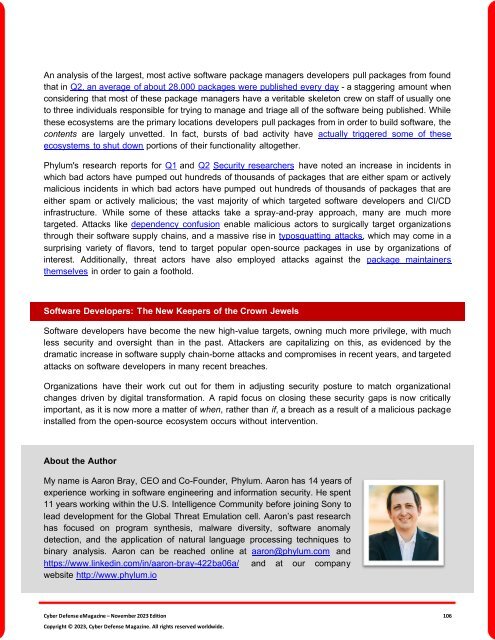The Cyber Defense eMagazine November Edition for 2023
Cyber Defense eMagazine November Edition for 2023 #CDM #CYBERDEFENSEMAG @CyberDefenseMag by @Miliefsky a world-renowned cyber security expert and the Publisher of Cyber Defense Magazine as part of the Cyber Defense Media Group as well as Yan Ross, Editor-in-Chief and many more writers, partners and supporters who make this an awesome publication! 196 page November Edition fully packed with some of our best content. Thank you all and to our readers! OSINT ROCKS! #CDM #CDMG #OSINT #CYBERSECURITY #INFOSEC #BEST #PRACTICES #TIPS #TECHNIQUES
Cyber Defense eMagazine November Edition for 2023 #CDM #CYBERDEFENSEMAG @CyberDefenseMag by @Miliefsky a world-renowned cyber security expert and the Publisher of Cyber Defense Magazine as part of the Cyber Defense Media Group as well as Yan Ross, Editor-in-Chief and many more writers, partners and supporters who make this an awesome publication! 196 page November Edition fully packed with some of our best content. Thank you all and to our readers! OSINT ROCKS! #CDM #CDMG #OSINT #CYBERSECURITY #INFOSEC #BEST #PRACTICES #TIPS #TECHNIQUES
You also want an ePaper? Increase the reach of your titles
YUMPU automatically turns print PDFs into web optimized ePapers that Google loves.
An analysis of the largest, most active software package managers developers pull packages from found<br />
that in Q2, an average of about 28,000 packages were published every day - a staggering amount when<br />
considering that most of these package managers have a veritable skeleton crew on staff of usually one<br />
to three individuals responsible <strong>for</strong> trying to manage and triage all of the software being published. While<br />
these ecosystems are the primary locations developers pull packages from in order to build software, the<br />
contents are largely unvetted. In fact, bursts of bad activity have actually triggered some of these<br />
ecosystems to shut down portions of their functionality altogether.<br />
Phylum's research reports <strong>for</strong> Q1 and Q2 Security researchers have noted an increase in incidents in<br />
which bad actors have pumped out hundreds of thousands of packages that are either spam or actively<br />
malicious incidents in which bad actors have pumped out hundreds of thousands of packages that are<br />
either spam or actively malicious; the vast majority of which targeted software developers and CI/CD<br />
infrastructure. While some of these attacks take a spray-and-pray approach, many are much more<br />
targeted. Attacks like dependency confusion enable malicious actors to surgically target organizations<br />
through their software supply chains, and a massive rise in typosquatting attacks, which may come in a<br />
surprising variety of flavors, tend to target popular open-source packages in use by organizations of<br />
interest. Additionally, threat actors have also employed attacks against the package maintainers<br />
themselves in order to gain a foothold.<br />
Software Developers: <strong>The</strong> New Keepers of the Crown Jewels<br />
Software developers have become the new high-value targets, owning much more privilege, with much<br />
less security and oversight than in the past. Attackers are capitalizing on this, as evidenced by the<br />
dramatic increase in software supply chain-borne attacks and compromises in recent years, and targeted<br />
attacks on software developers in many recent breaches.<br />
Organizations have their work cut out <strong>for</strong> them in adjusting security posture to match organizational<br />
changes driven by digital trans<strong>for</strong>mation. A rapid focus on closing these security gaps is now critically<br />
important, as it is now more a matter of when, rather than if, a breach as a result of a malicious package<br />
installed from the open-source ecosystem occurs without intervention.<br />
About the Author<br />
My name is Aaron Bray, CEO and Co-Founder, Phylum. Aaron has 14 years of<br />
experience working in software engineering and in<strong>for</strong>mation security. He spent<br />
11 years working within the U.S. Intelligence Community be<strong>for</strong>e joining Sony to<br />
lead development <strong>for</strong> the Global Threat Emulation cell. Aaron’s past research<br />
has focused on program synthesis, malware diversity, software anomaly<br />
detection, and the application of natural language processing techniques to<br />
binary analysis. Aaron can be reached online at aaron@phylum.com and<br />
https://www.linkedin.com/in/aaron-bray-422ba06a/ and at our company<br />
website http://www.phylum.io<br />
<strong>Cyber</strong> <strong>Defense</strong> <strong>eMagazine</strong> – <strong>November</strong> <strong>2023</strong> <strong>Edition</strong> 106<br />
Copyright © <strong>2023</strong>, <strong>Cyber</strong> <strong>Defense</strong> Magazine. All rights reserved worldwide.

















